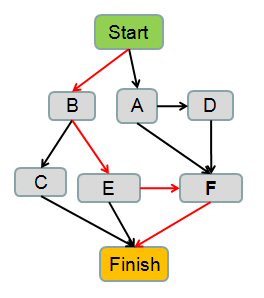 When first you heard of the PERT Diagram, it was probably in relation to engineering, architecture, or other construction or manufacturing tools. Have you thought of PERT as tool for controlling business meetings? Why not? Each meeting is a never-before event. US Navy’s motivation for developing PERT: controlling the development of the never-before Polaris submarine.
When first you heard of the PERT Diagram, it was probably in relation to engineering, architecture, or other construction or manufacturing tools. Have you thought of PERT as tool for controlling business meetings? Why not? Each meeting is a never-before event. US Navy’s motivation for developing PERT: controlling the development of the never-before Polaris submarine.
Every meeting element is unique but interdependent. It must be gauged in advance so meeting-callers understand the meeting’s Gestalt. Only then can meeting-callers determine the relative value and requirement of the individual elements, as well as the whole. Don’t try to wing-it. If there’s no Gestalt, you can’t buy protection for any intended message. So severe and so frequent are business meetings failures that one training company placed a full-page ad in a related trade magazine to try to shift blame away from the technology, the supposed ‘answer’ to all ‘non-existent’ problems (“Training”; Mar-Apr,’09; page 15).
Meeting-Managers (and all -callers) must regain control of the message before control of meetings and wanted-results is possible. Again, Meeting Manager vs meeting planner. Management and control begins with your understanding of your message needs, not hotel and airline reservations. Logistics are important if unavoidable but contribute nothing to message-understanding and fulfillment.
PERT delivers visualized control of the entire meeting structure. Time-oriented, PERT demonstrates that logistics devour your coordination time. Yet logistics are less important in total than the message’s priority needs.
Recommendation: Use PERT together with the military’s original ISD (Instructional Systems Development) process. That pairing is dynamite!
ISD demands that you know exactly what your message requires and then helps you (step-by-step) to fulfill the dictates of that message. Using PERT, military personnel create workable programs anywhere in the world to answer immediate needs effectively. Commercial ISD disk programs require you to choose among relative strengths and weaknesses of proprietary versions of the military original before you buy. That requires basic knowledge of ISD before you shop. Gotcha!
ISD/PERT requires you to think of every meeting in terms of both its message and its logistics and how they’re best brought together. Why? You can’t make piano music until you’ve learned to finger the keys. These communications keys will harmonize your objectives and results:
Consider every meeting’s needs and agenda before all else:
- Is your do-able purpose stated succinctly and clearly?
- Intended response: what should participants logically do as a result?
- How does the new action differ from old methods and information?
- What new tools are needed to aid and accommodate new activities?
- Will those tools be available at your meeting? If not, when?
- Have you provided practice time with new tools for participants?
- Have you planned with authorities/designer/developer to produce needed tools?
- Have you refined your key address to answer every element of message and its true requirements? Unexamined technology is not itself an adequate answer. (A future blog.)
- Have you determined the proper setting: in-house, local, national?
- Are you providing logistical support for that setting, if needed? PERT!
With dictates above fulfilled, be confident that meetings will work. You’ll also set standards for The Other Guy, who conducts lousy meetings.
Attention to message is free of cost–just deliver needed time and thought. Too rushed? Remember the adage: “Why is there never time to do it right but always time to do it over?” There’s no second chance with a failed meeting because you might already have disproved your own expertise. Here, their perception counts for more than fact.
Complications involved in creating competent meetings are visible on our PERT Diagram graphic. There, our ten points above are condensed into a single feeder bar in the multi-line/bar PERT arrow.
To download a usable PERT chart, see www.meetings/Cavalier.com; choose ‘Business Writing”; click ‘Recognition.’ Below the Note, multiple buttons include ‘Book AOM and early mag articles.’ Our original PERT Diagram and its notes follow the “AOM” book cover. Find fuller explanations and expanded how-to re: PERT in related books “AOM” and “SMTW.”
For more information re: ISD, click ‘Titles’; see “Common Sense ISD” book, a complete how-to. The “ISD” book webfile offers actual (but partial) opening Phase I (of 5 Phases), a brief example of military ISD’s step-by-step method.

A different approach to project management meetings. In this case, no time and effort will be wasted. Great great post.
Great pointers on thinking through the mechanics of a meeting. I have been in too many meetings where participants spend time dialing-in or connecting because they are not familiar with equipment and tools. Waste of everyone’s time I say.